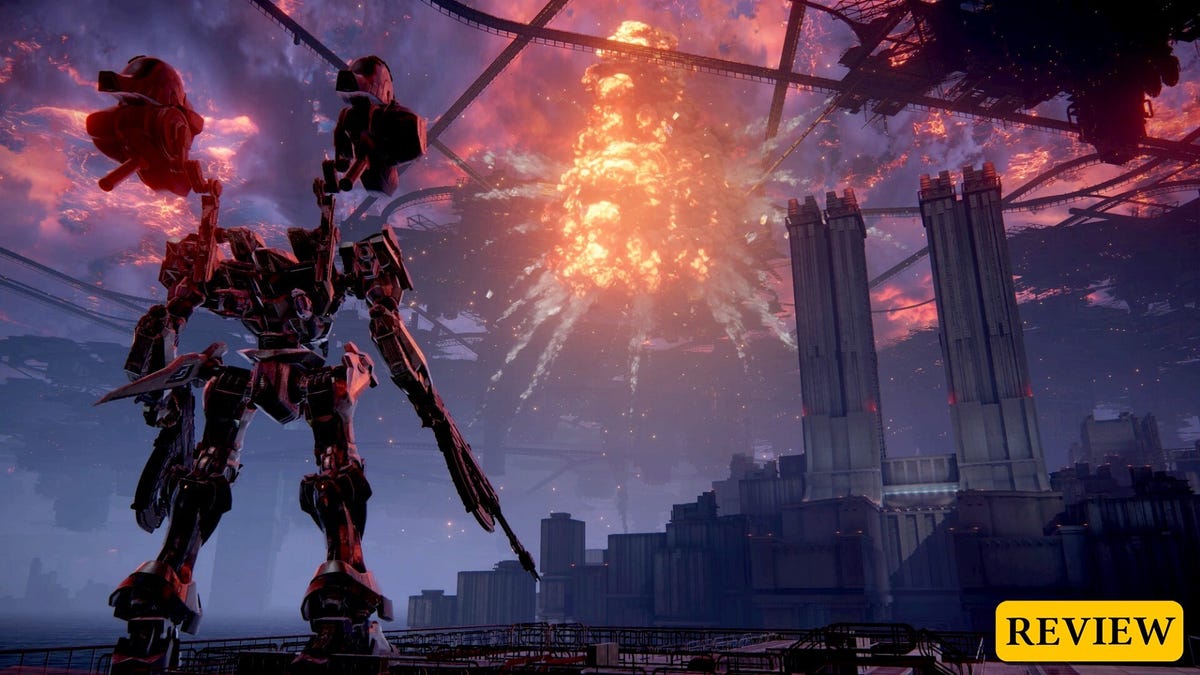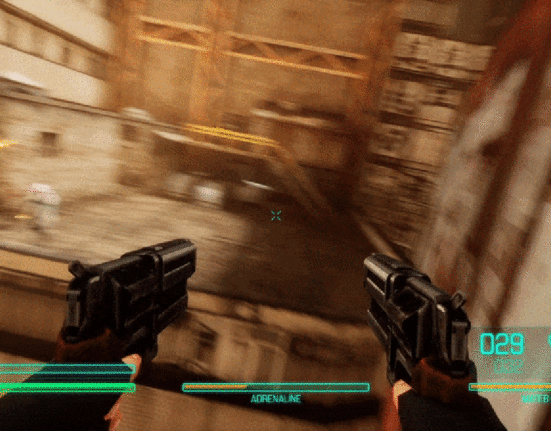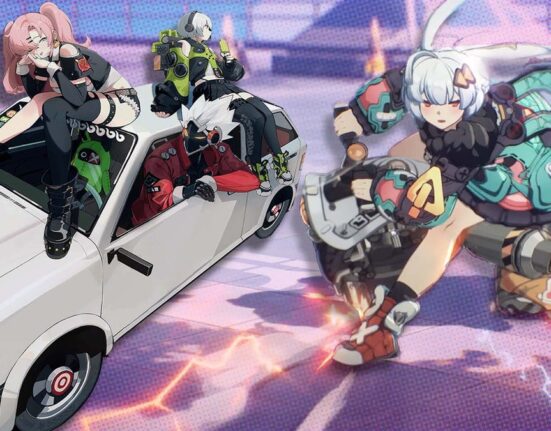IIt’s 3:30 a.m., my palms are sweaty, my heart is pounding, and a small mech riding on a tank blows me up for the 11th time. The rubber nubs on my controller’s thumbsticks had started rubbing off long ago, but now they’re completely decimated. The PS5 DualSense was not built for this. Armored Core VI’s demanding tactics focused on simultaneous movement and gunfire mean that at any point you could be pressing and executing multiple actions at once, and are often called on to chain them in quick succession. The results are sometimes messy, but more often than not equal parts exhilarating and exhausting.
By the end of Armored Core VI, I’d betrayed everyone I’d known. It was lonely, standing atop a giant aircraft carrier city in a distant star system ravaged by brutal conflicts that began well before I’d arrived and would continue long after I was gone. It was also thrilling, knowing what I’d overcome to get there and the choices I’d made along the way to become something deadlier than anyone who’d ever tried to get in my way. Armored Core VI is very special. I haven’t played a game like this in a long time.

How does multiplayer work?
Armored Core VI features online multiplayer including 1v1 and 3v3 fights. I haven’t been able to test it enough for the purposes of this review, and will cover my impressions of it in a seperate write-up once the mode is live for everyone following the game’s launch. But I’m pretty excited to be playing this game for a long time.
There have been over a dozen sequels, expansions, and spin-offs in the years since the first Armored Core was released on the PS1 in 1997. Though each tinkered with the basic formula, speeding up the action or slowing it down, leaning into the sci-fi dystopian lore or pulling back from it, prioritizing single-player campaigns or doubling down on online multiplayer, the series has, in the West at least, often been treated with something between grudging admiration and quizzical disregard.
After FromSoftware’s Dark Souls games took off for their radical reinterpretation of the fantasy action-RPG genre, Armored Core continued to struggle. Despite dramatically improving on its muddled, multiplayer-centric predecessor, 2012’s Armored Core V: Verdict Day was largely dismissed as another ugly rehash of an impenetrable formula. Now the series is back after 10 long years, and a whole lot has changed. But in some ways Armored Core VI feels very much the same, and I hope people might finally be ready for it. I certainly am.
Out August 24 on PlayStation, Xbox, and PC, Armored Core VI: Fires of Rubicon is a game about engineering power out of chaos and learning, first as theory and second through practice, the complex relationships between a hundred different components so that you can eventually reach for the right one for the right job in a particular moment without even thinking about it. You pilot an Armored Core—developer FromSoftware’s bespoke term for giant freaking robot. This means flying around a mix of grim sci-fi ruins and dazzling atmospheric skies swinging big laser swords and shooting massive guns.
Buy Armored Core VI: Fires of Rubicon: Amazon | Best Buy | GameStop
It also means spending an equal amount of time meticulously optimizing performance by swapping out individual pieces, each with a stat sheet long enough to put your average Final Fantasy hero to shame. The hangar where this all happens is called the Assembly, and it’s a set of menus that act as glorified spreadsheets documenting how each part you’ve collected will slightly alter the performance of your Armored Core.
This requires choosing a strategy based around the legs—tank treads or hovering spider octopus legs, sturdy supports or springy reverse-joints—and building out from there, making sure to balance your loadout’s overall performance with the weight and energy demands of each individual piece. It’s completely overwhelming until it’s not, at which point you feel like Matt Damon scribbling formulas on the chalkboard at MIT in the middle of the night.
For all its initial complications, there’s something tenaciously old-school about Armored Core VI. In many ways it’s a very traditional Armored Core game, but the qualities that make it one—arcadey action, limited progression systems, minimalist presentation—are the very same characteristics that make it feel like an emphatic rejection of most contemporary gaming trends. There’s no crafting or random busywork, no open-world maps littered with extraneous icons to clean up. It makes Armored Core VI feel streamlined and uncluttered, fantastic at what it does and completely uninterested in everything else.
Playing as an unnamed mercenary who never shows their face or utters a word, I bypass the orbital defenses of the distant planet Rubicon to take part in a resource war over a rare, potent, volatile substance called Coral. It’s essentially space oil, promising a high-tech revolution and untold carnage wherever it’s found. It was responsible for an environmental disaster that engulfed much of the planet half a century ago, but its reemergence has ignited a bloody race between off-world corporations, interstellar governments, and local liberation movements. The perfect playground for 100-ton mechs that rocket through the air and hit like freight trains.
Buy Armored Core VI: Fires of Rubicon: Amazon | Best Buy | GameStop
My handler Walter calls me “621,” a reference to the number of biologically altered test pilots who came before me—while my rivals call me “hound,” an indictment of my lack of freedom and imagination. A hired gun would at least get to choose the contracts they take. Mine are given to me by people who know better, or at least more than they’re telling me. I get pitched an offer, digest the mission briefing, and then tinker with my mech until I’m satisfied it will be good enough to get the job done while still allowing me room to experiment with an ever-growing menu of machine guns, missile launchers, armored joints, battery packs, and thrusters.
What begins as glorified gig work—taking dirty jobs for competing corporations to worm my way into their trust and confidence—eventually embroils me in a geopolitical conflict that has no winners, just survivors who make it to the next round. Progressing in Armored Core VI means becoming one of them, climbing past a roster of other ambitious careerists, social outcasts, and psychopaths until my arrival on any given battlefield sends NPCs screaming into their comms for backup. One of Armored Core VI’s bleaker lessons is that it almost never comes.
The story is told sparingly, dotted across brief conversations over the radio and lore entries tucked away in a few collectibles and menu descriptions. It’s simple, but full of texture and nuance. The corporations want to pay you to help them mine another planet to extinction. A faction of Rubiconians believe the Coral has a deep connection to humanity that goes beyond fuel and want you to aid them in their fight for freedom. Everyone is at the mercy of forces larger than themselves, but the mechs leave open the possibility that even one person can rewrite their fate, and the planet’s.
I was perpetually intrigued despite it always keeping me at arm’s length. Distrust and alienation are a feature in Armored Core VI, not a bug, and it does a superb job of conveying the seductive but eerie appeal of traipsing across desolate cities and arctic tundras just so you can light up whatever you find with a dozen high-impact bazooka shells. On the ground, Armored Core VI can occasionally look awkward in its toy model proportions, but when it takes to the skies it offers some breathtaking sci-fi backdrops and evocative environments. Exploring their intricate visual details thanks to the game’s robust verticality helps bridge the gaps in its otherwise sparse script.
Armored Core VI nails a certain synth-infused post-apocalyptic vibe, but it’s the combat and especially the boss fights that make it feel high-stakes and ripe with drama. In one early mission I take out a massive walking cannon shaped like a grasshopper in the desert. In another I survey for Coral deposits near an old mine shaft. Sooner or later I arrive at a boss fight that stops me in my tracks. First it’s a bulldozer shaped like a tractor trailer. Next it’s another mech inside spherical armor that fires so many homing missiles it feels like I’m back in an ancient 8-bit bullet hell shoot ‘em up. But Armored Core VI is not nearly so two-dimensional. It’s more like Mega Man X fused with Star Fox.
I can dash in any direction, fly 1,000 feet up in the air, and fire more weapons than I have fingers to pull the triggers for. Half the battle is just remembering every option available to me at every second and deploying all of them in the most damaging and economical patterns possible. The other half is learning how seemingly minor tradeoffs in my loadout can drastically change the outcome of an encounter. Small increases to AP, your Armored Core’s health, can have a big impact on survivability, while moderate increases in boost speed and energy recovering can make dodging even the most unrelenting assault of laser blasts and mechanical arms feel feasible.
One key feature Armored Core VI does borrow from Elden Ring and the other Soulsborne games (director Masaru Yamamura was a lead designer on Sekiro: Shadows Die Twice) is a stagger system. Rack up enough impact damage quickly and your enemy will be briefly stunned, leaving it open to easy attacks and extra damage. Managing this meter, as well as your own version of it, can make or break fights, adding even more wrinkles to how you tinker with your mech and where you focus your situational awareness during combat.
Starting out in Armored Core VI is a lot like fumbling around in a dark, messy tool shed searching for the right size wrench. You flip the light switch on but the bulb flickers and burns out. You stub your toe on something jagged, heavy, and cold on the floor. You repeatedly run your hands over the workbench and walls hoping to catch the feel of something smooth and metallic that’s just the right size and weight to maybe be the very specific thing you need in this exact moment to move forward with the task at hand.
Then you find the tool you’re looking for. And then another, and another. You replace the light bulb and as you rummage through old boxes and paint cans, you begin to sort everything into its right place. Several hours and a dozen tangential errands later, you’re ready to fix the faucet that broke, the tire that’s flat, or one of the hundred other annoyances standing between you and your best life. More importantly, the tool shed itself is more organized, and with it your understanding of one small sliver of the obstacles and opportunities facing your corner of the universe.
If Armored Core VI was all just slamming your head against difficult boss battles, it would feel frustrating and oppressive, and get old real quick. Instead, the natural ebb and flow of the game lets you explore ghostly urban hellscapes, dunk on rank-and-file enemies, and earn extra credits in-between the tougher encounters to let off steam and build up your arsenal. An Arena mode lets you compete against every other mercenary in the game, rising up the leaderboard of notoriety and unlocking chips that can be used to acquire new customization options and stat upgrades for your machine. The game is extremely generous, except in a handful of moments when it’s pushing you to work hard, grow, and apply what you’ve learned to overcome odds that always seem impossible until you manage to surpass them with ease. These moments are quietly shocking and incredibly fulfilling.
A boss fight at the end of chapter one {the game has five) saw me facing off against the autonomous PCA craft “AAP07 Balteus’’ (everything is a mashup of alphanumeric designations and nouns that sound cool). It kicked my ass for several hours. Across multiple days, in fact. I kept trying to stick to my guns and beat the fight using a conventional build with some otherwise good weapons that catered toward the enemy’s weaknesses. Even once I had figured out the first phase of the fight, the second one, which brings out huge flamethrower swords, kept tripping me up.
Finally, I relented and went for a super light build. It immediately paid dividends. I managed to stay airborne higher and longer, avoiding attacks with ease and consistently getting the boss down to just a sliver of health until finally I’d defeated it. The fight trained me in very specific ways to overcome the Balteus, but being open to experimentation, trial and error, and a willingness to backslide on my existing progress in pursuit of new information and strategies was what ultimately unlocked the path forward. The sheer number of variables to tinker with in each encounter, on the fly, including my own understanding of the skirmish and how to respond to it, is what makes Armored Core VI so great, and why it’s clear it needed to come back.
The name “Armored Core” is meant to distinguish the vehicles I pilot from lowly tanks, helicopters, and “MTs.” Unlike these fixed pieces of machinery, the core is a central chamber that’s readymade to drop into any configuration you can think of, infinitely adaptable and ever evolving. Playing Armored Core VI frequently feels like reenacting your favorite anime robot sequence while looking and sounding like one of the scrappy mech suits from Aliens or The Matrix, hissing and screeching with every exploded piston and thruster boost.
The central fantasy of every FromSoftware game is pretty much the same—that through close observation and relentless practice you too can bootstrap your way to greatness, slay the dragon, save the kingdom, or solve the puzzle to unlock the mysteries of the universe. In many of the Soulsborne games this means mastering the violent gauntlet ahead of you. In Armored Core VI it means changing yourself until that death march becomes a cakewalk instead. It’s a game about having faith in yourself, even when no one else does, and becoming an ass-kicking mech pilot in the process, not because it will save the world, but because it’s cool as shit.
Buy Armored Core VI: Fires of Rubicon: Amazon | Best Buy | GameStop







Leave feedback about this